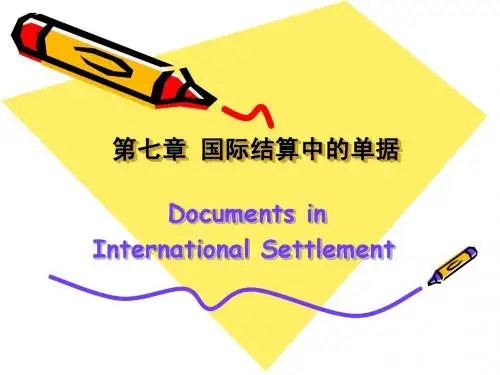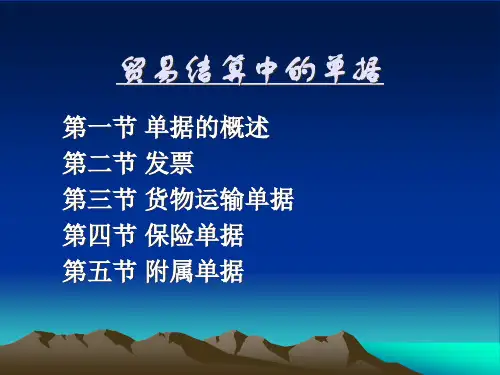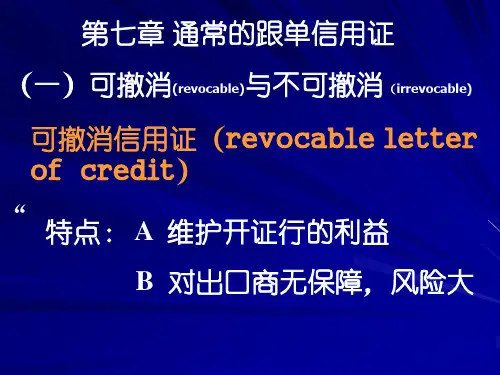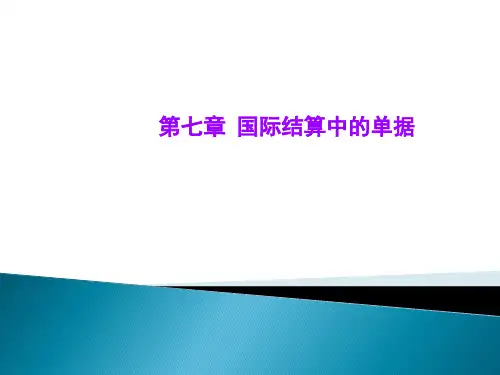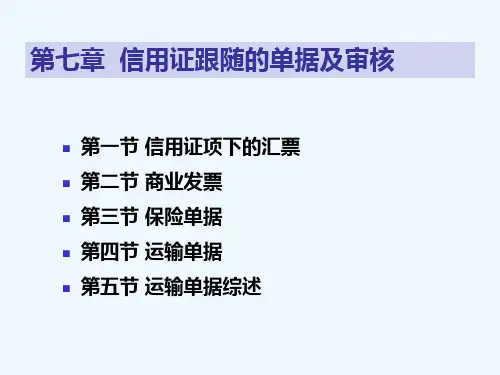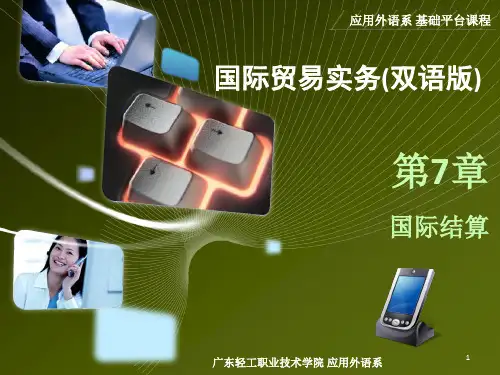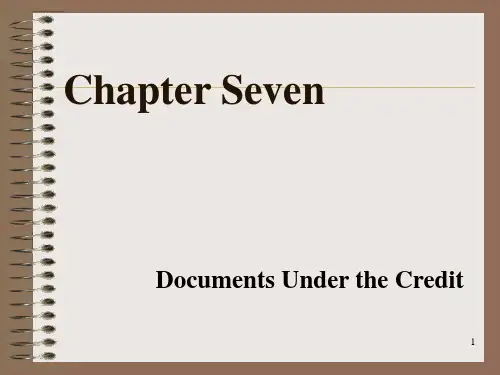国际结算chapter 7-documents.
- 格式:ppt
- 大小:367.50 KB
- 文档页数:12
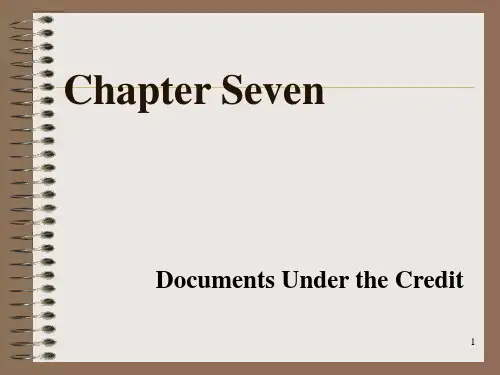
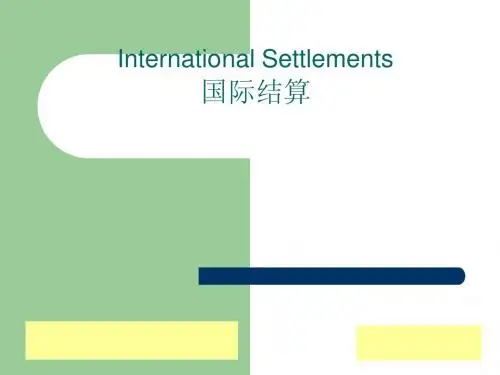
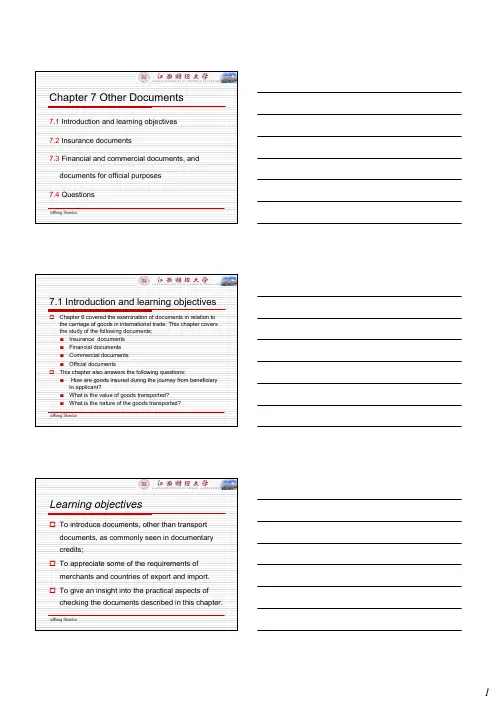
Chapter 7 Other Documents7.1Introduction and learning objectives7.2Insurance documents7.3Financial and commercial documents, anddocuments for official purposes7.4Questions©Wang Shanlun7.1 Introduction and learning objectives Chapter 6 covered the examination of documents in relation to the carriage of goods in international trade. This chapter covers the study of the following documents:Insurance documentsFinancial documentsCommercial documentsOfficial documentsThis chapter also answers the following questions:How are goods insured during the journey from beneficiary to applicant?What is the value of goods transported?What is the nature of the goods transported?©Wang ShanlunLearning objectivesTo introduce documents, other than transport documents, as commonly seen in documentarycredits;To appreciate some of the requirements of merchants and countries of export and import.To give an insight into the practical aspects of checking the documents described in this chapter.©Wang Shanlun©Wang Shanlun7.2 Insurance documents Insurance policy, insurance certificate and cover note Insurance terms as commonly seen AverageFranchise or an excess (deductible) Deck shipmentClaim payable at …Warehouse-to-warehouse clause ©Wang Shanlun7.2 Insurance documents General requirementsOnly one insurance document should be submitted under a credit covering the same risks for the same shipment. There may, however, be the need, in certain circumstances, to spread the risk between insurers and, in such cases ISBP paragraph 174 states …An insurance document should not evidence cover for goods not requested in the credit.Insurance documents must appear to have been countersigned where there is a requirement for such on the face of the document.Insurance documents must be endorsed as required to assign the rights to the applicant or other party named in the credit. (ISBP Para.179/180)©Wang Shanlun A study of the applications of the provisions of UCP600 in insurance documents commonly stipulated in credits UCP600 Art.28 ISBP681 Para.170~180 Art.28(a) –issue and signature Art.28(a) –open cover Art.28(b) –originalsArt.28(c) –cover notesArt.28(e) –date of issuanceArt.28(f) –currency and minimum coverArt.28(g~j) –types of insurance coverCommon discrepancies that arise upon document checking1.The currency in which the insurance document is expressed is notthat of the credit.2.The amount of insurance is insufficient.3.The merchandise description is not consistent with the credit orinvoice description.4.The port of loading or place of taking in charge is not in accordancewith the credit.5.Specific risks as stipulated in the credit are not annotated in orcovered by the document.6.Certificates are not countersigned where such countersignature isrequired.7.The insurance policy is not endorsed in terms of the credit.8.The effective date for insurance is later than the date of shipment.9.All the originals shown on the document as issued are not presented.©Wang Shanlun7.3 Financial and commercial documents, and documents for official purposesFinancial documentsISBP681 Para.43~56Corrections and alterationsCalculation of maturityPayment at maturity©Wang ShanlunCommercial documentsCommercial invoiceIssued by The beneficiary of the credit.Content A description and value of goods and terms of sale and other detail as stipulated in the credit. It would be considered safe toshow the wording of the credit precisely and additional informationshould not be in conflict with such wording.Purpose To evidence the manner in which the drawing under the credit is made up and to evidence the sale of goods in the termsrequired by the credit.UCP600 Art.18, ISBP681 Para.57~67©Wang ShanlunCommercial documentsCertified invoiceIssued by The beneficiary of the credit.Content Similar to the commercial invoice, together with certification by the beneficiary or third party interms of the credit. eg, a beneficiary may be required tocertify that the contents are correct and in terms of thepro forma invoice.Purpose To satisfy a specific concern of the buyer in relation to the certification required.©Wang ShanlunCommercial documentsCertificate of analysisCertificate of weightInspection certificatePacking listWeight listUCP600 Art.14(f)©Wang ShanlunDocuments for official purposesCertificate of originISBP681 Para.181~185Consular invoiceLegalised invoiceExport licenceHealth certificateUCP600 Art.3, 14(d), 14(f)ISBP681 Para.13, 14, 15, 22, 41, 42©Wang ShanlunCommon discrepanciesDiscrepancies on financial documentsDraft not signed by the beneficiary.Draft signed but no indication of the name of the beneficiary.Draft not endorsed as required.Draft not drawn on the correct party.Amount is in excess of the credit.Words and figures do not agree.Tenor of draft shown incorrectly.©Wang ShanlunCommon discrepanciesDiscrepancies on commercial invoicesNot issued by the beneficiary.Not signed as required by the credit.Description of goods on invoice does not correspond with the description of goods shown on the credit.Invoice not visaed or legalized as required by the credit.Quantity of goods shipped exceeds tolerance of 5% in sub-article 30(b).Unit price not as stipulated in the credit.Partial shipment effected when credit prohibits part shipment.Shipping marks and numbers on invoice not consistent with marks and numbers on the transport documents.©Wang ShanlunCommon discrepanciesCertificate of originIndicates the origin of the goods to be other than as stipulated in the credit.Certificate not issued by party as stipulated in the credit.Certificate does not indicate that it has been legalized and visaed as required by the credit.Legalization not in terms of the credit.Data on document in conflict with other documents.©Wang Shanlun7.4 Questions1.Do you clearly understand the differences betweeninsurance policies, insurance certificates, declarationsunder open cover and cover notes?2.Why is it important to examine the insurance document toascertain where claims are payable if the credit stipulates claims payable at a particular city or country?3.Because document examiners cannot be expected to readthe entire text of the insurance document, can you recallthe elements for which you will look and which form yourown functional standard?©Wang Shanlun7.4 Questions4.On which parties are drafts usually drawn underdocumentary credits and on which party should they not be drawn?5.Which type of credit availability will never call forpresentation of a draft?6.Do you understand the impact and application of thevarious tolerances defined in article 30?7.Why must documents issued for official purposes beprecise regarding the issuer and data content?©Wang Shanlun。

